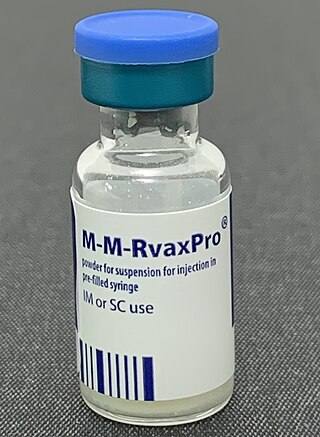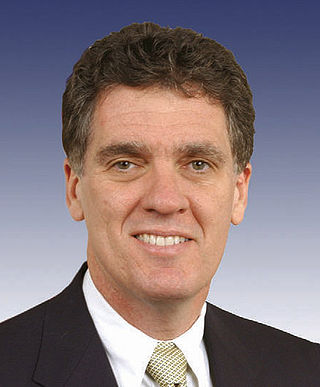Related Research Articles

Measles is a highly contagious, vaccine-preventable infectious disease caused by measles virus. Other names include morbilli, rubeola, red measles, and English measles. Both rubella, also known as German measles, and roseola are different diseases caused by unrelated viruses.

The MMR vaccine is a vaccine against measles, mumps, and rubella, abbreviated as MMR. The first dose is generally given to children around 9 months to 15 months of age, with a second dose at 15 months to 6 years of age, with at least four weeks between the doses. After two doses, 97% of people are protected against measles, 88% against mumps, and at least 97% against rubella. The vaccine is also recommended for those who do not have evidence of immunity, those with well-controlled HIV/AIDS, and within 72 hours of exposure to measles among those who are incompletely immunized. It is given by injection.

Rubella, also known as German measles or three-day measles, is an infection caused by the rubella virus. This disease is often mild, with half of people not realizing that they are infected. A rash may start around two weeks after exposure and last for three days. It usually starts on the face and spreads to the rest of the body. The rash is sometimes itchy and is not as bright as that of measles. Swollen lymph nodes are common and may last a few weeks. A fever, sore throat, and fatigue may also occur. Joint pain is common in adults. Complications may include bleeding problems, testicular swelling, encephalitis, and inflammation of nerves. Infection during early pregnancy may result in a miscarriage or a child born with congenital rubella syndrome (CRS). Symptoms of CRS manifest as problems with the eyes such as cataracts, deafness, as well as affecting the heart and brain. Problems are rare after the 20th week of pregnancy.

Congenital rubella syndrome (CRS) occurs when a human fetus is infected with the rubella virus via maternal-fetal transmission and develops birth defects. The most common congenital defects affect the ophthalmologic, cardiac, auditory, and neurologic systems.

David Joseph Weldon is an American politician and physician. He was a Republican member of the United States House of Representatives, representing Florida's 15th congressional district, and was an unsuccessful candidate for the Republican nomination in Florida's 2012 U.S. Senate race.

Robert Francis Kennedy Jr., also known by his initials RFK Jr., is an American politician, environmental lawyer, author, anti-vaccine activist, and conspiracy theorist. He is the nominee for United States Secretary of Health and Human Services in President Donald Trump's second cabinet.

Stanley Alan Plotkin is an American physician who works as a consultant to vaccine manufacturers, such as Sanofi Pasteur, as well as biotechnology firms, non-profits and governments. In the 1960s, he played a pivotal role in discovery of a vaccine against rubella virus while working at Wistar Institute in Philadelphia. Plotkin was a member of Wistar’s active research faculty from 1960 to 1991. Today, in addition to his emeritus appointment at Wistar, he is emeritus professor of Pediatrics at the University of Pennsylvania. His book, Vaccines, is the standard reference on the subject. He is an editor with Clinical and Vaccine Immunology, which is published by the American Society for Microbiology in Washington, D.C. and one of the leading vaccine advocates. Dr. Plotkin disclosed his consulting work for various vaccine manufacturers as a potential conflict of interest to his vaccine advocacy, including Merck, GSK, Sanofi, and Pfizer, as well as multiple biotech companies.

The National Childhood Vaccine Injury Act (NCVIA) of 1986 was signed into law by United States President Ronald Reagan as part of a larger health bill on November 14, 1986. NCVIA's purpose was to eliminate the potential financial liability of vaccine manufacturers due to vaccine injury claims to ensure a stable market supply of vaccines, and to provide cost-effective arbitration for vaccine injury claims. Under the NCVIA, the National Vaccine Injury Compensation Program (NVICP) was created to provide a federal no-fault system for compensating vaccine-related injuries or death by establishing a claim procedure involving the United States Court of Federal Claims and special masters.
The MMRV vaccine is a combination vaccine which combines the attenuated virus measles, mumps, rubella, and varicella (chickenpox). The MMRV vaccine has similar immunogenicity and overall safety profiles to the MMR vaccine administered with or without the varicella vaccine. The MMRV vaccine is typically given to children between one and two years of age.
An attenuated vaccine is a vaccine created by reducing the virulence of a pathogen, but still keeping it viable. Attenuation takes an infectious agent and alters it so that it becomes harmless or less virulent. These vaccines contrast to those produced by "killing" the pathogen.
Claims of a link between the MMR vaccine and autism have been extensively investigated and found to be false. The link was first suggested in the early 1990s and came to public notice largely as a result of the 1998 Lancet MMR autism fraud, characterised as "perhaps the most damaging medical hoax of the last 100 years". The fraudulent research paper, authored by Andrew Wakefield and published in The Lancet, falsely claimed the vaccine was linked to colitis and autism spectrum disorders. The paper was retracted in 2010 but is still cited by anti-vaccine activists.

ACAM2000 is a smallpox vaccine and an mpox vaccine manufactured by Emergent Biosolutions. It provides protection against smallpox for people determined to be at high risk for smallpox infection. ACAM2000 is a live replicating vaccinia virus vaccine.

Andrew Jeremy Wakefield is a British fraudster, discredited academic, anti-vaccine activist, and former physician.

Measles vaccine protects against becoming infected with measles. Nearly all of those who do not develop immunity after a single dose develop it after a second dose. When the rate of vaccination within a population is greater than 92%, outbreaks of measles typically no longer occur; however, they may occur again if the rate of vaccination decreases. The vaccine's effectiveness lasts many years. It is unclear if it becomes less effective over time. The vaccine may also protect against measles if given within a couple of days after exposure to measles.

Rubella vaccine is a vaccine used to prevent rubella. Effectiveness begins about two weeks after a single dose and around 95% of people become immune. Countries with high rates of immunization no longer see cases of rubella or congenital rubella syndrome. When there is a low level of childhood immunization in a population it is possible for rates of congenital rubella to increase as more women make it to child-bearing age without either vaccination or exposure to the disease. Therefore, it is important for more than 80% of people to be vaccinated. By introducing rubella containing vaccines, rubella has been eradicated in 81 nations, as of mid-2020.
Dorothy Millicent Horstmann was an American epidemiologist, virologist, and pediatrician whose research on the spread of poliovirus in the human bloodstream helped set the stage for the development of the polio vaccine. She was the first woman appointed as a professor at the Yale School of Medicine and she held a joint appointment in the Yale School of Public Health.
The use of fetal tissue in vaccine development is the practice of researching, developing, and producing vaccines through growing viruses in cultured (laboratory-grown) cells that were originally derived from human fetal tissue. Since the cell strains in use originate from abortions, there has been opposition to the practice and the resulting vaccines on religious and moral grounds.
In February 1998, a fraudulent research paper by physician Andrew Wakefield and twelve coauthors, titled "Ileal-lymphoid-nodular hyperplasia, non-specific colitis, and pervasive developmental disorder in children", was published in the British medical journal The Lancet. The paper falsely claimed causative links between the measles, mumps, and rubella (MMR) vaccine and colitis and between colitis and autism. The fraud involved data selection, data manipulation, and two undisclosed conflicts of interest. It was exposed in a lengthy Sunday Times investigation by reporter Brian Deer, resulting in the paper's retraction in February 2010 and Wakefield being discredited and struck off the UK medical register three months later. Wakefield reportedly stood to earn up to US$43 million per year selling diagnostic kits for a non-existent syndrome he claimed to have discovered. He also held a patent to a rival vaccine at the time, and he had been employed by a lawyer representing parents in lawsuits against vaccine producers.
Extensive investigation into vaccines and autism spectrum disorder has shown that there is no relationship between the two, causal or otherwise, and that vaccine ingredients do not cause autism. The American scientist Peter Hotez researched the growth of the false claim and concluded that its spread originated with Andrew Wakefield's fraudulent 1998 paper, and that no prior paper supports a link.

Hope Elizabeth Hopps was an American microbiologist and immunologist who retired from the US Food and Drug Administration having served as assistant director of the Bureau of Biologics. She published 89 articles in scientific journals and books, and was awarded two patents related to vaccine development.
References
- ↑ Saxon, Wolfgang (August 25, 2001). "Harry Martin Meyer Jr., 72; Helped Create Rubella Vaccine" – via NYTimes.com.
- ↑ Archives, L. A. Times (August 27, 2001). "Dr. Harry Meyer; Co-Developer of Vaccine for German Measles". Los Angeles Times.
- ↑ https://www.washingtonpost.com/archive/local/2001/08/22/harry-meyer-jr-dies/707bf1f5-b010-470a-8f35-6f648e542fdf/